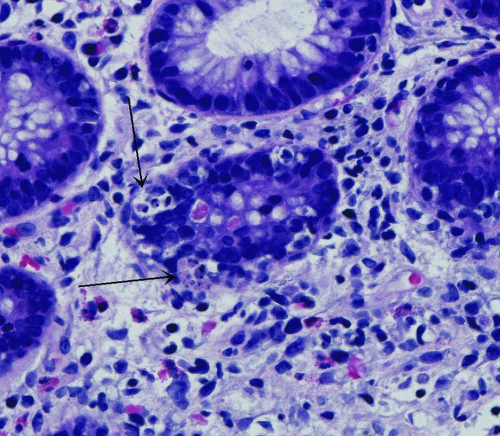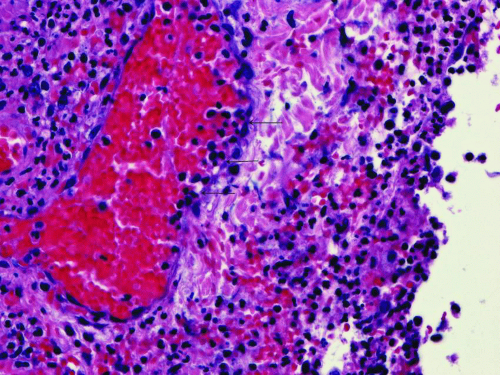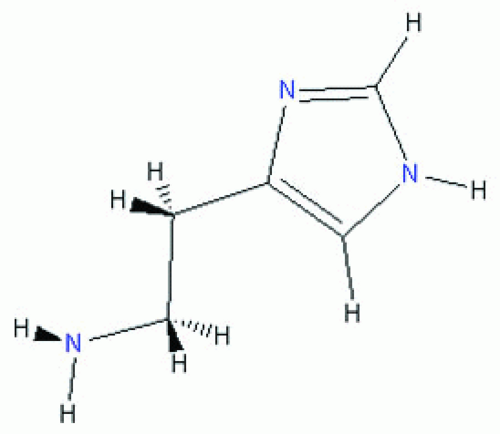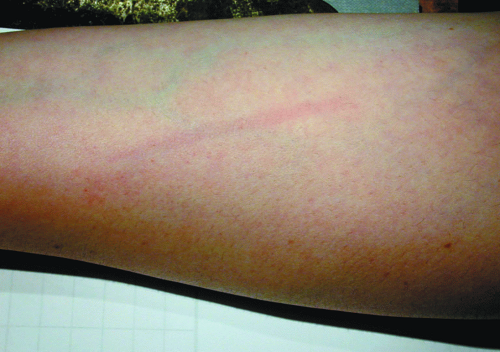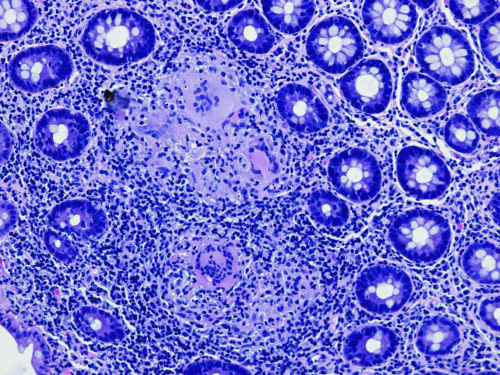General and Autopsy Pathology
Atif Ahmed
▪ Questions and Answers
1. All of the following agents and molecules are known causes of cell injury EXCEPT:
a. Monoxyhemoglobin
b. Alcohol
c. Acetaminophen
d. ATP
e. IgG
View Answer
1. d. Cell injury can be caused by physical agents such as extremes of temperature, chemical agents such as drugs and toxins, infectious organisms, immunologic agents, and deficiency of nutrients and oxygen to the cells such as in monoxyhemoglobinemia. ATP is a natural substance that plays a role in energy, metabolism, and cell survival.
2. Which of the following ultrastructural features of cell injury are considered irreversible?
a. Myelin figures
b. Swelling of endoplasmic reticulum
c. Mitochondrial densities
d. Cytoplasmic vacuoles
e. Pyknotic nuclei
View Answer
2. e. Cell death occurs by apoptosis or oncosis (cell swelling). Pyknotic, karyolytic, and karyorrhectic nuclei are examples of irreversible processes that occur with cell death. Other processes such as formation of membrane myelin figures, cytoplasmic vacuolization, swelling of endoplasmic reticulum, and mitochondrial densities can be found in reversible cell injury.
Questions 3 and 4:
This is a stomach biopsy taken from a patient who received a bone marrow transplant for myelodysplastic syndrome (Fig. 1.1).
3. All of the following statements concerning the process depicted in the gastric glands are true EXCEPT:
a. It results from immunologic injury.
b. It is triggered by decreased bcl2/p53 ratio.
c. It can effectively be reversed by “Survivin.”
d. It occurs as sequence of the activation of caspase 3.
e. It is an example of irreversible cell injury.
View Answer
3. c. Apoptosis is an irreversible process that is triggered by increased TNF and a p53/bcl2 ratio and is not usually associated with inflammation. It can be blocked (but not reversed) by apoptosis inhibitor proteins such as survivin. It may occur as normal physiologic or pathologic processes as seen in hepatitis or graft-versus-host disease (immunologic injury).
4. Biological events leading to the process seen in Figure 1.1 can occur through any of the following sequences EXCEPT:
a. Fas, Fas-associated death domain, caspase 8, caspase 3
b. TNF, death domains, procaspase 2, caspase 3
c. P53, death receptors, caspase 3, caspase 9
d. Bax, cytochrome c, APAF-1, caspase 9
e. TRAIL, death receptors, caspase 8, caspase 3
View Answer
4. c. Intracellular proteolysis is carried out by the caspases, which can be classified into procaspases such as caspase 8 or 9 and effector caspases such as caspase 3. Activation of caspase 3 is a late event in apoptosis.
5. Ki-67 (MIB-1) index is increased in:
a. Hypertrophy
b. Metaplasia
c. Hyperplasia
d. Atrophy
View Answer
5. c. Hyperplasia involves cell division, is part of the tissue response in wound healing, and may be accompanied by an increased MIB-1 proliferation index. On the other hand, hypertrophy occurs in nondividing cells and may show polyploidy. Both hyperplasia and hypertrophy are influenced by cytokines and growth factors.
6. This is a section of the mucosa of the trachea (Fig. 1.2). The process shown in this image can be induced by any of the following factors EXCEPT:
a. Vitamin A deficiency
b. Mechanical intubation
c. Hypoglycemia
d. Chronic inflammation
e. Smoking
View Answer
6. c. Squamous metaplasia of the bronchial epithelium can be caused by intubation trauma, chronic bronchitis, vitamin A deficiency, and damage due to smoking.
7. Calcification is a prominent component of which of the following pathologic entities?
a. Psammoma bodies
c. Corpora amylacea
d. Gamna Gandy bodies
e. Kimmelstiel-Wilson lesions
View Answer
7. a. Cells of certain carcinomas forming papillary structures tend to calcify, forming tiny gritty calcified bodies called psammoma bodies. Corpora amylacea is a glycogen-like material with attached phosphate and sulfate groups and occurs in aging brains and in the prostate. Hypercalcemia and metastatic calcifications can occur in sarcoidosis but sarcoid granulomas do not usually have central necrosis or calcifications. Gamna Gandy bodies are organized and fibrotic deposits of hemosiderin in the spleen caused by hemorrhage. Kimmelstiel-Wilson lesions contain basement membrane material deposited in the glomeruli of diabetic patients.
8. Which statement best characterizes telomerase?
a. It shortens telomere length by removing nucleotides at the end of the chromosome.
b. It is up-regulated in cancer cells.
c. It is expressed in most somatic cells.
d. It is important in cell apoptosis.
e. It is activated during G1 phase of cell cycle.
View Answer
8. b. Telomerase enzyme adds nucleotides to the end of chromosomes and is important in cell aging. It is absent in most nondividing somatic cells but is up-regulated in cancer cells, stem cells, and dividing germ cells.
9. Mutations in the DNA helicase gene result in:
a. Formation of colonic polyps
b. Apoptosis
c. Accelerated aging
d. Megalencephaly
e. Cell hypertrophy
View Answer
9. c. Mutations of the DNA helicase gene (WRN gene) occur in Werner syndrome, possibly accounting for the increased cell aging. Accelerated aging is also seen in Cockayne syndrome, Bloom syndrome, and progeria.
10. The earliest event in acute inflammation is:
a. Vasodilatation
b. Increased vascular permeability
c. Endothelial contraction
d. Leukocyte margination
e. Increased hydrostatic pressure
View Answer
10. a. Vasodilatation leads to increased hydrostatic pressure and increased vascular permeability. Vasodilatation is induced by histamine, serotonin, and bradykinin, which can also cause increased vascular permeability.
11. The most common mechanism involved in increased vascular permeability is through:
a. Histamine acting on venules
b. Cytokine-mediated formation of endothelial gaps
c. VEGF acting on endothelial cells
d. Leukocyte-mediated endothelial injury
e. Bacteria-mediated endothelial cell necrosis
View Answer
11. a. Histamine and other mediators produce an immediate effect on venules, leading to vascular leakage. Vascular leakage can also occur by direct injury, in granulation tissue, and in diapedesis.
12. Physiologic events depicted in this image (Fig. 1.3) are induced by mediators released in which of the following sequences?
a. P-selectin, β-integrin, PECAM 1
b. E-selectin, PECAM 1, integrins
d. Redistribution of P-selectin, IL1, ICAM 1
e. L-selectin, P-selectin, VLA-4
View Answer
12. a. The image shows leukocyte adhesion and transmigration through a dilated vein in the wall of inflamed appendix. Selectins are involved in rolling and loose adhesion. Firm adhesion (or sticking) is brought about by linking of integrins (CD11a/CD18 forming a heterodimer called LFA-1) and ICAM-1 (member of the immunoglobulin family). PECAM 1 (platelet endothelial cell adhesion molecule 1) is essential for transmigration or diapedesis.
13. Major chemotactic agents for leukocytes include all of the following mediators EXCEPT:
a. Formyl-methionyl-leucyl-phenylalanine (fMLP)
b. Complement 5a
c. Leukotriene B4
d. Interleukin 8
e. Prostaglandin A1
View Answer
13. e. Chemotactic agents for leukocytes are diverse and include bacterial products such as endotoxin lipopolysaccharides and fMLP, complement components C3a, C4a, C5a, thrombin, fibrinolytic breakdown products, chemokines, and leukotrienes. Prostaglandin A1 as well as several serum factors such as chemotactic factor inactivator (CFI) are actually inhibitors of chemotaxis.
14. Leukocyte “activation” results in:
a. Increased surface expression of LFA-1
b. Dephosphorylation of protein kinases
c. Increased surface expression of P-selectin
d. Phagocytosis
e. All of the above
View Answer
14. a. Phagocytosis and chemotactic stimuli (antigen-antibody complexes, complement 5a, TNF) activate leucocytes, leading to increased surface expression of LFA-1 integrin family and change in their configuration so that they can bind to endothelial ligand, ICAM-1.
15. Injection of this molecule (Fig. 1.4) in laboratory animals directly leads to:
a. Increased vascular permeability
b. Proliferation of fibroblasts
c. Activation of complement
d. Bronchodilatation
e. Blood clotting
View Answer
15. a. This is histamine which, when injected, produces acute inflammation with pain and arteriolar dilatation and increased vascular permeability. Histamine is stored in mast cells and platelets.
16. Primary defects in leukocyte phagocytosis and intracellular killing occur in all of the following conditions EXCEPT:
a. Leukocyte adhesion deficiency
b. Chediak Higashi syndrome
c. X-linked gp91 phox deficiency
d. Myeloperoxidase deficiency
e. Glutathione reductase deficiency
View Answer
16. a. Chronic granulomatous disease (resulting from X-lined mutation in the NADPH oxidase enzyme [gp91 phox deficiency]), myeloperoxidase deficiency, glutathione reductase deficiency, and Chediak-Higashi syndrome are all primarily defects of phagocytosis and intracellular killing. Leukocyte adhesion deficiency syndromes are autosomal recessive conditions characterized by recurrent infections, pneumonia, and sepsis in paradoxical association with neutrophilic leukocytosis. In type I of this disorder, neutrophils lack the cell surface glycoproteins CD11/CD18, resulting in decreased adhesion and motility.
17. All of the following mediators are considered inhibitors of acute inflammation EXCEPT:
a. Prostaglandin E1
b. Nuclear factor (NF) κB
c. Bacterial leukocidin
d. Alpha-1 antitrypsin
e. COX-1 inhibitors
View Answer
17. b. NF-κB is a cytoplasmic molecule that locates to the nucleus to activate genes related to inflammation. PGE1 antagonizes the effect of histamine, serotonin, and other mediators and, unlike PGE2, is classified as an anti-inflammatory agent. Leukocidins produced by staphylococci and protease inhibitors such as alpha-1 antitrypsin also inhibit the effect of inflammation.
18. Serotonin differs from histamine in the fact that serotonin:
a. Stimulates fibrosis via fibroblasts
b. Is not released by platelets
c. Causes increased vascular permeability
d. Does not result in arteriolar dilatation
e. Secretion is limited to carcinoid tumors
View Answer
18. a. Serotonin, similar to histamine, is released by platelets and results in increased vascular permeability and arteriolar dilatation. Unlike histamine, serotonin stimulates fibroblasts and may result in fibrosis.
19. The lectin pathway of complement activation involves:
a. C3a
b. Collectins
c. Properdin
d. Peanut lectins
e. Prekallikrein
View Answer
19. b. Collectins bind to carbohydrates on surfaces of bacteria and other organisms and activate the classic pathway. Complement components mediate many aspects of acute inflammation, including increased vascular permeability, leukocyte chemotaxis, phagocytosis by neutrophils, and degranulation of mast cells. C3a, C4a, and C5a are anaphylatoxins and can also cause vascular leakage. C3b is also involved in phagocytosis by opsonization.
20. Activated Hageman factor (factor XIIa) leads to:
a. Bradykinin formation
b. Fibrin formation
c. Fibrin breakdown
d. Activation of complement
e. All of the above
View Answer
20. e. Activated Hageman factor actives four enzyme cascades: the kinin system, clotting system, fibrinolytic system, and complement.
21. Which of the following membrane protein receptors has the ability to “recognize” microbe-derived molecules?
a. Seven transmembrane G-protein-coupled receptors
b. Peroxisome proliferator-activated receptor
c. Tyrosine kinase receptors
d. Toll-like receptors
e. Hormone receptors
View Answer
21. d. Toll-like receptors recognize microbial molecules, such as gram-negative bacterial lipopolysaccharides, peptidoglycans, and bacterial lipoproteins, and in turn activate innate immune response against microbial organisms.
22. In reference to the pathway in Figure 1.5, “??” mediators:
a. Cause vasodilatation
b. Cause vasoconstriction
c. Result in increased vascular permeability
d. Cause bronchospasm
e. Inhibit neutrophil chemotaxis
View Answer
22. e. Lipoxins are negative regulators of leukotrienes and inhibit neutrophils chemotaxis. On the other hand, leukotrienes can cause chemotaxis and vasoconstriction while prostaglandin E2 causes vasodilatation.
23. Which of the following statements is NOT true about chemokines?
a. They are large protein complexes.
c. They are induced by interleukin-1.
d. They are caused by neutrophil chemotaxis.
e. They serve as receptors for HIV virus.
View Answer
23. a. Chemokines are small, 8-10 KD proteins that include interleukin 8, C-X-C chemokines, and C-C chemokines. The group has chemotactic specificity for leukocytes and also serves as receptors for HIV virus.
24. Defense against damage by free radicals employs all of the following factors EXCEPT:
a. Catalase
b. Superoxide dismutase
c. Vitamin E
d. Nitric oxide
e. Peroxidase
View Answer
24. d. Nitric oxide is produced by the enzyme nitric oxide synthase, which uses the substrate L-arginine. It is a free radical but also has important functions in inflammation. It reduces platelet aggregation and leukocyte adhesion and causes vasodilatation. Transferrin and ceruloplasmin are serum protein antioxidants that are also important in the O2-radicals scavenger system.
25. The enzyme catalyzing the following reaction in the human body: O2− + O2 + 2H → H2O2 + O2
a. Is important in the elimination of free radicals
b. Forms hydrogen peroxide, which is a natural antioxidant
c. Uses an iron molecule as a catalyst
d. Is part of the antioxidant system in the plasma
e. Uses nitric oxide as a substrate
View Answer
25. a. Superoxide dismutase, together with catalase, is part of the enzyme system that eliminates free radicals. Superoxide dismutase forms hydrogen peroxide, which is then eliminated by catalase. Superoxide dismutase is an intracellular enzyme found mainly in mitochondria and the cytosol.
26. A scratch by a pen resulted in this skin response (Fig. 1.6). Inflammatory mediators released in this response include:
a. Histamine
b. Substance P
c. Both histamine and substance P
d. None of the above
View Answer
26. c. Substance P is released by sensory nerve endings and degranulates mast cells. Mast cells secrete histamine, which causes local vasodilatation. In triple skin response, as shown in the picture, a red line appears first because of vasodilatation followed by a red flare spreading to several centimeters from the line. Skin swelling (a wheal) then forms after a few minutes and is caused by vascular leakage. Platelet-activating factor also has versatile function in acute inflammation with possible exception of vasodilatation. It is produced from neutrophils, eosinophils, platelets, vascular endothelial cells, vascular smooth muscle cells, monocytemacrophages, renal epithelial cells, and mesangial cells.
27. Fibroblasts differentiate into myofibroblasts through:
a. Production of a fibronectin coating on the plasma membrane
b. Forming intracytoplasmic bundles of fibers and dense bodies
c. Acquisition of collagen-synthesizing enzymes
d. Production of MyoD1 family of proteins
e. Acquiring receptors for platelet-derived growth factors
View Answer
27. b. Myofibroblasts have distinctive features not found in fibroblasts. These include expression of alphasmooth muscle actin, cytoplasmic fibrils with dense bodies, and extensive gap junctions between cells. These features allow the myofibroblasts to have contractile properties, which are important in wound closure. Myo D1 is protein involved in myogenesis and is not found in myofibroblasts.
28. Fibrosis is induced by all of the following mediators EXCEPT:
a. Platelet-derived growth factor
b. Heparin
c. Transforming growth factor
d. Fibronectin
e. Fibroblast growth factor
View Answer
28. b. The list of cytokines that induce fibrosis is long and includes platelet-derived growth factor, insulin-like growth factor, fibroblast growth factors, and fibronectin. Fibronectin, although does not induce fibroblasts, plays a secondary role and forms, with fibrin filaments, scaffold, or footholds for epidermal cells and migrating fibroblasts.
29. Eosinophils accumulate in parasitic infections under the influence of:
a. IgM
b. Lymphotoxin
c. Eotaxins
d. Major basic protein
e. γ-interferon
View Answer
29. c. Eosinophils are important in the defense against parasites. They differentiate in the bone marrow under the influence of interleukins 5 and 3. Eotaxins 1 and 2 are chemokines that act as chemotactic factors that cause eosinophils to migrate from blood vessels and accumulate in tissue. Eosinophils, similar to neutrophils, can phagocytize and kill bacteria and generate superoxide anions.
30. Factors involved in the formation of this colonic lesion (Fig. 1.7) include all of the following cytokines EXCEPT:
a. IL-12
b. γ-interferon
c. Platelet-derived growth factor
d. Chemokines
e. Elastases
View Answer
30. e. IL-12, produced by macrophages and dendritic cells, is crucial in T-helper lymphocyte response and induction of delayed hypersensitivity. γ-Interferon is also a key mediator of delayed-type hypersensitivity and is a powerful activator of macrophages. Platelet-derived growth factor stimulates fibroblast proliferation and collagen synthesis. Other cytokines that play a role in delayed hypersensitivity include IL-2, TNF, lymphotoxin, and chemokines such as IL-8.
31. Systemic symptoms and signs of inflammation are mediated by all of the following proinflammatory cytokines EXCEPT:
a. TNF
b. IL-1
c. IL-8
d. IL-4
e. IL-2
View Answer
31. d. Interleukin (IL) 1 and TNF are proinflammatory cytokines that produce fever, inflammation, and tissue destruction when administered to humans. IL-8 is a chemoattractant for neutrophils and causes degranulation. Interferon-γ is also considered a proinflammatory molecule because it augments TNF and induces nitric oxide. Major anti-inflammatory cytokines that control the proinflammatory response include IL-1 receptor antagonist, IL-4, IL-10, and IL-13.
32. Match each of the following receptor descriptions with their common ligands listed below.
i) Receptors with intrinsic kinase activity
ii) Receptors without intrinsic kinase activity
iii) Seven-spanning receptors
a. Growth factors
b. Cytokines
c. p53 protein
d. Steroid hormones
e. Nonsteroid hormones
View Answer
32. i) a. Receptors with intrinsic kinase activity include growth factors such as TGF-alpha, PDGF, c-kit, and insulin. These activate receptor tyrosine kinase, which phosphorylates effector molecules such as phospholipase C-γ and PI-3 kinase.
ii) b. Receptors for many cytokines lack intrinsic tyrosine kinase activity.
iii) e. Seven transmembrane receptors are couples to G-proteins and include receptors for many physiologic peptides and hormones such as epinephrine and vasopressin as well as pharmaceutical drugs. These receptors also involve cAMP.
33. Which of the following growth factors mediate the events involved in wound repair?
a. Fibroblast growth factor
b. Platelet-derived growth factor
c. Epidermal growth factor
d. Transforming growth factor
e. All of the above
View Answer
33. e. Epidermal growth factor, fibroblast growth factor, transforming growth factor, platelet-derived growth factor, and VEGF are major cytokines involved in wound healing.
34. Match each of the following matrix proteins with their characteristic functions listed below.
i) Hyaluronic acid
ii) Collagen
iii) Fibrillin
a. Is a member of intercellular adhesion molecules
b. Accumulates in patients with thyroid hormonal dysfunction
c. Accumulates in patients with cutis laxa
d. Helps in the assembly of elastic fibers
e. Defective cross-linking leads to homocystinuria
View Answer
34. i) b. Proteoglycans are components of connective tissue, retain water in the interstitial spaces, and are responsible for subcutaneous tissue turgor. Proteoglycans, especially hyaluronic acid, accumulate in patients with severe hypothyroidism “myxedema” and also in the pretibial spaces in patients with Grave disease. They are also involved in the pathology of joints. ii) e.




Stay updated, free articles. Join our Telegram channel

Full access? Get Clinical Tree



